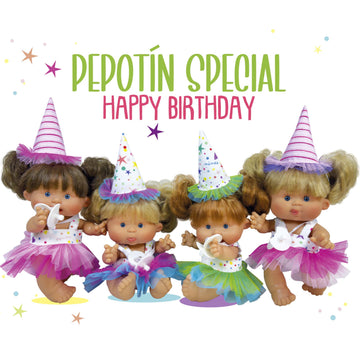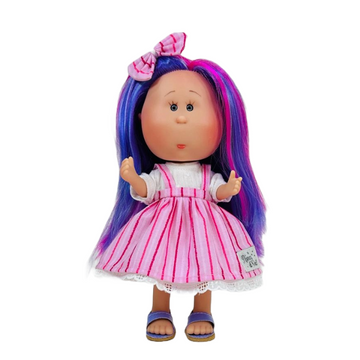The Definitive Guide for Dolls And Accessories
The Definitive Guide for Dolls And Accessories
Blog Article
The Basic Principles Of Dolls And Accessories
Table of ContentsHow Dolls And Accessories can Save You Time, Stress, and Money.3 Easy Facts About Dolls And Accessories DescribedThe Dolls And Accessories StatementsThe Buzz on Dolls And AccessoriesGet This Report about Dolls And AccessoriesThe Basic Principles Of Dolls And Accessories The 5-Second Trick For Dolls And Accessories
When dolls are included in group play, children practice waiting, sharing, and paying attention to others' ideas. Whether they're claiming to be a moms and dad, brother or sister, or good friend, youngsters discover how connections workhow to sustain others, address disagreements, and look after somebody else. These early role-play experiences come to be the foundation for healthy relationships and relationships later in life.Repeating comforting regimens with a doll (feeding, shaking, closing) can assist kids feel calm and secure. These soothing routines show them just how to self-regulate. Looking after a doll can make a kid feel qualified and certain - baby dolls. It gives them a feeling of duty and control in a world that often really feels uncertain.
The Buzz on Dolls And Accessories
When children see dolls that mirror their race, heritage, and society, it reinforces a positive feeling of identity. It says, "You belong. Your story issues." Dolls also introduce youngsters to cultures outside their own, constructing considerate interest and empathy for others. This is where inclusive play can cause comprehensive areas.
As Dr. Karyn Purvis, a leader in youngster development and trauma-informed treatment, when said: This effective quote highlights how play isn't simply funit's exactly how kids discover best. The brain wires itself via repeating. Yet when a kid is involved, joyful, and emotionally attached to an activitylike doll playthe mind reinforces those connections much faster and more meaningfully.
The Ultimate Guide To Dolls And Accessories

Children require compassion, compassion, and imagination tooand doll play supplies that. Dolls are usually a child's first "pal," aiding them practice partnerships, construct interaction skills, and feel comforted.
A Biased View of Dolls And Accessories
With dolls that matter. Samantha Ong Samantha Ong is the founder of Joeydolls, a Canadian-based toy brand name on an objective to celebrate Asian societies via happy, comprehensive play. Inspired by her very own experiences expanding up without cultural depiction, Samantha creates dolls that aid children feel pleased of who they are while triggering curiosity and compassion in others.
Playing with dolls urges children to talk more regarding others' ideas and feelings, a research study has actually located. The research recommends that playing fictional games with dolls can assist children develop social skills, concept of mind and compassion.
Getting The Dolls And Accessories To Work
They were likewise more probable to attend to the dolls in the second person, talking with them directly, whereas the personalities on the computer display they had a tendency to describe in the third person. No difference was observed between children and girls."Internal state language can suggest that a kid is assuming about other individuals's ideas and emotions while having fun with dolls," said Gerson.
And that they see language usage in this regard is excellent confirmation of the theory."Mardell added that the searchings for ought to apply to any kind of kind of role-play toy, rather than being specific to Barbies."Kid commonly start to reveal signs of interior state language around the age of 4.
The Ultimate Guide To Dolls And Accessories
"It comes to be important for making and maintaining friendships, and how they pick up from their instructors, and parents."The research study also discovered that the children had actually increased mind task in the posterior premium temporal sulcus (pSTS) region when they talked as though their dolls had thoughts and feelings. The pSTS area is thought to be entailed in the growth of social and psychological processing skills.
Childhood is not a fixed life phase; undoubtedly, the interpretation, significance and understanding of childhood are all based on alteration. By the 19th century among one of the most extensive changes was the value put on enabling kids to experience "the carefree pleasures" of youth through play activities. Play was currently considered to be an important component of an excellent childhood years.
In order to fully understand the significance of play, one should likewise recognize the significance of the doll. Dolls are a lot more than toys made to image source amuse young girls. Throughout the 19th century appropriate play tasks were chosen to promote intellectual, physical or emotional development. Dolls were specifically preferred since they were assumed to promote and nurture feminine high qualities such as generosity, caring and compassion.
See This Report about Dolls And Accessories

It is only via archaeological investigations that scientists can intend to discover and record the complete variety of playtime experiences. Narrating these experiences, and particularly the function of dolls, is critical for offering a more total image of childhood years during the 19th century. Alarcn, Sara E - european dolls., "Youngster's Play: The Role of Dolls in 19th Century Youth" (2007 )
Report this page